This is a Futura S, a 35mm rangefinder camera made by Futura Kamerawerk GmbH in Freiburg, West Germany starting in 1952. The Futura S was a later variant of the original Futura camera, first released in 1950. All Futura cameras featured a unique screw/breech lock interchangeable lens mount, a leaf shutter, and a coupled coincident image rangefinder. Although a well built cameras, Futura did little to differentiate themselves from much more popular German camera makers and would go out of business in 1957 making all Futura cameras uncommon today.
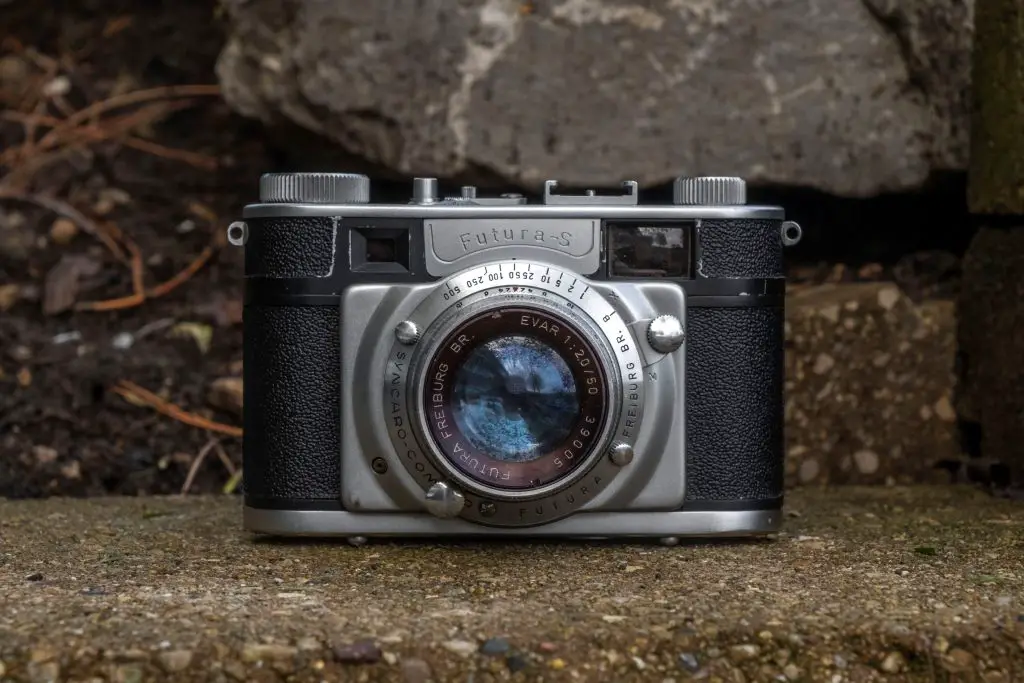 Film Type: 135 (35mm)
Film Type: 135 (35mm)
Lens: 50mm f/2 Futura Evar coated 6-elements
Lens Mount: Futura 33.8mm Screw Mount
Focus: Variable
Viewfinder: Coincident Image Coupled Rangefinder
Shutter: Synchro-Compur Leaf
Speeds: B, 1 – 1/500 seconds
Exposure Meter: None
Battery: None
Flash Mount: Coldshoe and M and X Flash Sync
Weight: 740 grams
Manual: https://www.cameramanuals.org/pdf_files/futura.pdf
Manual (different version): https://www.cameramanuals.org/pdf_files/futura_24x36.pdf
How these ratings work |
The Futura lineup of cameras was an attractive and capable rangefinder that had features comparable to many other more expensive German rangefinders, but sold at a lower price. I thought that some of the controls were haphazardly placed and I did not enjoy the design of the focus and aperture rings. Even worse, the example I had access to had some internal haze within the lens, but otherwise proved to be a capable, but forgettable camera. | ||||||
| Images | Handling | Features | Viewfinder | Feel & Beauty | History | Age | |
| 1 | 2 | 1 | 1 | 1 | 1 | 30% | |
| Bonus | none | ||||||
| Final Score | 9.1 | ||||||
History
In the world of German cameras, there are many well established brands. Leica, Zeiss, Voigtländer, and Kodak all produced wonderful cameras over many decades that are still very sought after today. But behind the success stories are a large number of brands that for one reason or another fell by the wayside, Apparate & Kamerabau, Bilora, Ising, and Leidolf are some of the many companies that either merged with a larger company or just closed their doors never to be heard from again.
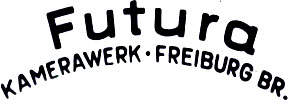 One company that falls into that second category is Futura. Originally formed in 1942 as an optics factory by the name, Fritz Kuhnert, Optische Anstalt, the company produced optical equipment for the German war effort during World War II. Not much else is known about the company or it’s founder, Fritz Kuhnert. How did he get started with optics? Did he previously work for a larger company like Zeiss or Schneider? What types of optical equipment did he make? Were they aerial cameras and lenses, or simpler devices like rangefinders or scopes? In my research for this article, I found absolutely no information about what exactly Fritz Kuhnert did before the war or the types of products produced by Fritz Kuhnert, Optische Anstalt.
One company that falls into that second category is Futura. Originally formed in 1942 as an optics factory by the name, Fritz Kuhnert, Optische Anstalt, the company produced optical equipment for the German war effort during World War II. Not much else is known about the company or it’s founder, Fritz Kuhnert. How did he get started with optics? Did he previously work for a larger company like Zeiss or Schneider? What types of optical equipment did he make? Were they aerial cameras and lenses, or simpler devices like rangefinders or scopes? In my research for this article, I found absolutely no information about what exactly Fritz Kuhnert did before the war or the types of products produced by Fritz Kuhnert, Optische Anstalt.
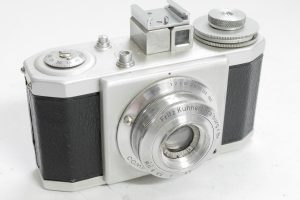
What I did find was the same couple of sentences repeated on nearly every website which was that during the war, the company’s factory was destroyed and the company was later reformed in 1946 with the intent of producing civilian cameras. It’s first camera was a simple scale focus camera called the Efka 24 which shot square 24mm x 24mm exposures on regular 35mm film. The name “Efka” is said to be a phonetic spelling of Fritz Kuhnert’s initials, “FK”.

It would take nearly 4 years before Fritz Kuhnert, Optische Anstalt would release a new product, but in 1950, a much more ambitious camera called the Futura would be released. The Futura would be a cleanly designed 35mm rangefinder camera that shot normal 24mm x 36mm images. It would have a combined coincident image rangefinder and a proprietary interchangeable screw lens mount.
The Futura would have it’s own lineup of lenses available, many of which were named after Kuhnert’s wife Elenore (Elor) and his two children, Eva and Peter (Evar and Petar). The lenses ranged from the wide angle Futura Ampligon 35mm f/4.5 to the telephoto Futura Tele Elor 90mm f/3.8. Perhaps the Futura’s most ambitious lens was a fast Futura Frilon 50mm f/1.5 lens which is still very desirable today.
Strangely, almost immediately after releasing the Futura camera, Fritz Kuhnert would sell his company to two brothers named Ernst and Eduard Komorowski who renamed the company Futura Kamerawerk GmbH and continued producing the Futura lineup of cameras.
In the ad to the right from September 1952, the Futura sold for between $127.95 to $197.25 depending on which lens it came with. When adjusted for inflation, these prices compare to $1230 to $1900 today which for a German made rangefinder with interchangeable lenses was quite a bargain.
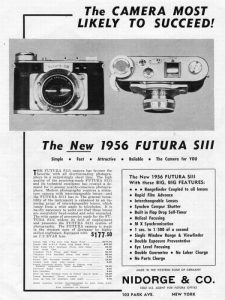
The Futura camera was produced until 1957 and only received minor updates along the way, mostly to the shutter, and in 1953 came a slight change to the lens mount which was backwards compatible with older lenses, but allowed for full rangefinder coupling to the wide angle and telephoto lenses.
Not much is known about Futura’s demise, but it is often repeated online that their owners ran into financial trouble and rather than invest in improving the lineup and trying to compete with the rapidly growing Japanese photo industry, they decided to liquidate the company’s factories and assets. Futura would close it’s doors in 1957 and would disappear into the history books.
Today, Futura cameras enjoy a positive reputation from collectors who like interchangeable lens German rangefinders, but want something different than Leicas. Like most camera systems, the lenses is where the real money is, and with ones with the more mundane f/3.5 or f/2.8 lenses can usually be found for a relatively low price. With the faster f/2 Evar or especially the f/1.5 Frilon, prices can escalate quickly.
My Thoughts
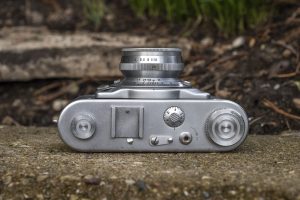
Although the top plate of the camera has most of the usual things you’d expect to see on a 1950s 35mm camera, the position of the controls seemed a little haphazard as if the designers just put things wherever it fit.
I’m a big fan of symmetry and the two different sizes for the rewind and wind knobs looks a little odd to me, almost as if the rewind knob was an afterthought. The accessory shoe performs the duties of an accessory shoe is just a simple piece of bent metal. It works fine, but again, seems like a missed opportunity for something just a bit nicer.
Below it is a very cheap looking sliding lever that points to one of three positions, SW, C, and CN. I can only imagine these are film types that were available upon the camera’s release. I’ve never been able to find a detailed Futura manual that explains what these mean, but whatever they are, they don’t actually control anything.
Edit 3/28/2020: After posting this article, reader David Babsky explained that the letters stand for: SW is ‘Schwartz/Weiss” (Black&White); C is ‘Color’; CN is ‘Color Negativ’.
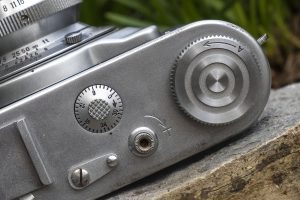
Next is a seemingly random layout of three more controls, the exposure counter, self-timer lever, and the cable threaded shutter release. Again, I get the impression that little thought was placed in the position of these controls. The exposure counter is additive and requires a downward press and a twist in order to reset to 0. The shutter release also can be twisted into a “Timed” mode, locking the shutter open when set to “B” mode for extra long exposures.
Finally, we have the film advance knob, which, like you might expect, is used to advance the film to the next position while simultaneously cocking the shutter.
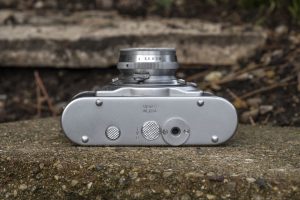
The bottom plate of the camera has four small divots that help stabilize the camera when set on the ground since the offset tripod socket is not flush with the rest of the bottom. Next to the tripod socket is the camera back release latch. To load film, you must press in on this button while simultaneously pushing it in the direction of the arrow. This allows the entire back and bottom of the camera to come off. Finally, there is the rewind activation lever, which when pressed in, disengages the film transport, allowing you to rewind exposed film back into the cassette.

Film transports from left to right onto a take up spool, which on the particular example I had for this review, was broken, so I had to secure the film leader to the spool with a small piece of tape. Other than this minor issue, the film compartment on the Futura looks like most other from it’s era.
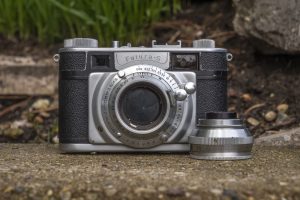
All Futura cameras share the same 33.8mm screw mount. Like other screw mounts, righty tighty, lefty loosey. It’s worth noting that starting with the Futura S, the lens mount was modified somewhat to allow for full coupling of wide and telephoto lenses. Even with this modification however, all previous lenses are backwards compatible.
By far, my biggest complaint of the camera is the design of the focus and aperture rings, which are both pressed tightly against the body of the camera. A small circular handle is the only way to grip either ring, and their locations can sometimes overlap each other, making feeling for them with the camera to your eye very difficult. Many cameras like the Lordomat have a similar shutter design behind a removable lens without this problem, so I wonder why the designers did it this way.
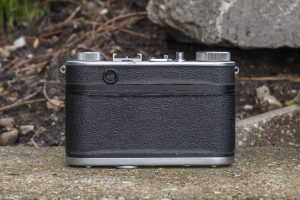
Around back, there’s not much to see. Just the circular viewfinder hole in the upper left corner.
Finally, we have the viewfinder, which sadly, I did not get an image of, but there’s not much to see. The Futura uses a pinkish rectangular coincident image rangefinder patch and nothing more. There are no frame lines, indicated shutter speeds, or any other information about the status of the camera.
Overall, the Futura S is a pretty camera that has some questionable locations of some of it’s controls. The focus and aperture controls are my biggest complaint, but I guess if this was my primary camera back in 1952, you probably could get used to it. But in an era with so many options, why would anyone want to force themselves to get used to something when there were so many better options out there?
Now that cameras like these largely sit unused on shelves, the Futura certainly looks pretty on a shelf, but what is it like to actually shoot it?
My Results
Although this Futura camera came to me in good working condition, I did notice a fair amount of internal haze inside the Evar lens. I wiped down the external surfaces of the lens but the haze was clearly inside the lens, and not willing to open up a lens I was so unfamiliar with, I made the decision to just load in some film and see what I could get. If the haze showed up on the negatives, perhaps I could minimize it through some creative use of Photoshop’s sliders. I loaded in some Fuji 200 and shot it in mid summer 2019.
As I had feared, the haze did show up on the film and no amount of creative edits in Photoshop could completely get rid of it. Not only did every image have a “sheen” over it, but the filtering from the haze seemed to have an effect on the colors of the images as everything seemed to have a washed out bluish cast.
There are those out there who might describe these images as having a vintage “glow” to them, but for me, this goes beyond endearing, and is just unappealing. Perhaps some high contrast black and white film would have been a better choice for this camera.
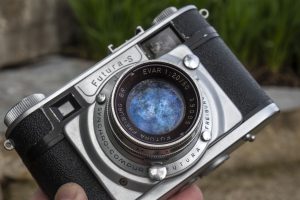
That said, I won’t fault a 67 year old lens for having conditional issues as the haze present in this example wouldn’t have been there when the camera was new. So looking past the altered colors and diffused look to the images, I can say that the 6-element Evar was probably a decent performer in it’s day. Sharpness is on par with other lenses of the era. Based on my own unscientific eye, I’d rate this lens as being on par the 50mm f/2.8 Lorodnar in the Leidolf Lordomat 35mm rangefinder which would have likely been this camera’s primary competition when it was first sold.
Moving on from my issues with the lens, the rest of the Futura S performed fine. The rangefinder was decently bright and easy to use and the shutter was accurate. The camera is attractive and has a nice bit of symmetry when looked at straight on. The rounded edges to the body meant it was comfortable to hold and could easily be stored in a large coat pocket or medium handbag. I could never get used to the very narrow focus and aperture rings around the camera, but then again, I only ever shot one roll. Maybe with repeated use, I would have gotten accustomed to it.
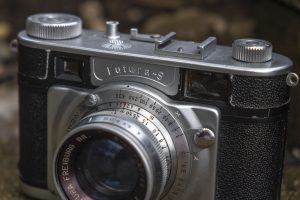
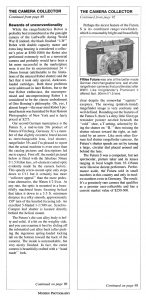
After reading about the history of Futura Kamerawerk’s relatively short lifespan, I can sort of see why. The camera exudes “meh” and it’s control layout feels haphazardly thought out. Comparing it again to the Lordomat, much of the Futura appears “off”. Not cheap, just a little less. Considering the high standards set by other German camera makers like Leitz and Zeiss, the Futura was likely doomed to fail in the marketplace, and that’s exactly what happened.
There’s a bit of irony that a camera called the “Futura” had nothing futuristic about it. There’s no clever new feature, or anything suggesting the designers were looking to create a camera of the future. Perhaps a better name for the camera should have been the Presenta, or the Currenta.
If you ever get a chance to shoot a Futura S, I recommend it. If anything, having a ho-hum experience with a model like this, allows you to appreciate other “top tier” cameras just a little more. As a collector/shooter, sometimes I get a little spoiled by all of the outstanding cameras I get to handle, sometimes you need a reality check to remember that not everything can be a Leica and the Futura S certainly isn’t.
Related Posts You Might Enjoy
External Links
http://camera-wiki.org/wiki/Futura_S
http://www.cjs-classic-cameras.co.uk/other/futura.html
https://www.rangefinderforum.com/forums/showthread.php?t=50288
https://www.photo.net/discuss/threads/another-frustrating-futura.459126/
https://www-usedcameracameracamera-com.translate.goog/camera/futura-s (in Japanese)


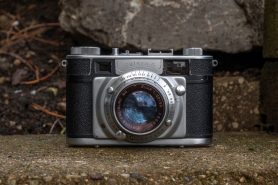













Hi Mike,
Great review again as I also have a couple of these Futura’s. One is a Futura S like this one and another is a Futura SIII with a rapid wind lever over the knob handle. I am assuming this was the final model of this company, to offer something a bit more enticing than the standard S model. I am always amazed at how much $$$, the 50/1.5 Frilon goes for on Ebay, even when the glass sometimes appears to look like a Coke Bottle. I can’t imagine what the 70/1.5 Frilon would go for, as I have never seen it offered. The other more common 35/4.5 Ampligon and the 90/5.6 Tele-Elor go for enough considering how slow they actually are compared to other lenses of the era. Again, as you said, I guess the uniqueness vs the other more well know brands of the 50’s holds a certain value.
Regards, Gary Hill
Glad you liked the review Gary! I don’t know if it’s just my bad luck or if there’s something more to it, but Futura lenses seem to have a higher chance than normal of having internal haze. Perhaps their manufacturing methods just haven’t held up as well over the years. I really liked the look of this camera, but sadly, I just didn’t like using it as much as I had hoped I would!
Interesting review of an uncommon camera, Mike. I’ve read on various analog forums that the Futura cameras are unreliable, despite having Compur shutters. Maybe something was lacking in assembly or inspection. The top plate looks to be a bargain stamped piece – resembling what you’d see on a FED or similar Russky camera. But there must be something appealing to them, judging by the >$600 prices seen on That Auction Site.
I have no doubt that in proper working order, the Futura was capable of great shots. But as you’ve noticed the top plate is haphazardly put together and theres just something about them that’s “less” than the typical 1950s rangefinder. Even comparing it to the Lordomat, I would not put them in the same category, at least from a quality standpoint. People’s willingness to pay high prices likely come down to them as a curiosity, and admittedly, they are attractive looking on a shelf!
Great write up Mike! I visit your site occasionally and was surprised to see a Futura. I’ve owned a Futura-S with the 1.5 Frilon lens for just over a year. I bought it a an estate sale on NYE 2018 and spent New Years Day searching the internet for info about it. You’ve done a great job compiling info about this obscure little camera. I’ve only ran a short roll of B&W through it to test it out. The wind advance occasionally skips a few frames so I’ve never used it much. I might have to take it out of the N-everReady case this spring and give it another try!
Thanks for the compliment Craig! The Futura is certainly an attractive camera and one that I’m sure after being serviced is capable of outstanding results. Mine had issues, but it was the first ever one I came across, so I did the review in the hope it would draw up some interest from other collectors such as yourself! 🙂
Thanks for this review, Mike. I came across this camera in my grandfather’s basement after he passed away – based on the writing on the interior of the leather case, he had purchased it while stationed in Germany in the 1950s with the RCAF.
Your writeup helped me to figure out the mechanics — I’ve never used a film camera, so I’m looking forward to tracking down some film and giving this a test run!
Nice review, as others have said.
I’m lucky to have found two S’s and they both seem to work. I actually have film in one now, and I’m going for that vintage look.
Thanks for this review Mike – it really helped me out when I picked up this camera in a collectibles shop a couple of months ago. It’s my first attempt at 35mm film, so being able to read about not only the mechanics of the Futura but also about its history was really useful.
I am glad you found it helpful, Katie! I hope your experience with the Futura encourages you to try more film cameras! 🙂
Very interesting for me. I have been studying the Futura cameras for 4 years, I have in my collection about 60 bodies and 90 lenses. I am making a database that currently has about 600 number of bodies that have been the subject of publications, sales, literature etc.
I would be delighted and very grateful if I could receive the numbers of your Future and objectives. The Gary Hill SIII is a real SIII or an S with rapid winder ? You can check parts of my studies on my website, futuracollector.es, Best regards, Jean-Louis A.